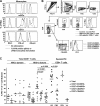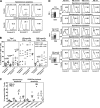PD-1 is a regulator of virus-specific CD8+ T cell survival in HIV infection
- PMID: 16954372
- PMCID: PMC2118095
- DOI: 10.1084/jem.20061496
PD-1 is a regulator of virus-specific CD8+ T cell survival in HIV infection
Abstract
Here, we report on the expression of programmed death (PD)-1 on human virus-specific CD8(+) T cells and the effect of manipulating signaling through PD-1 on the survival, proliferation, and cytokine function of these cells. PD-1 expression was found to be low on naive CD8(+) T cells and increased on memory CD8(+) T cells according to antigen specificity. Memory CD8(+) T cells specific for poorly controlled chronic persistent virus (HIV) more frequently expressed PD-1 than memory CD8(+) T cells specific for well-controlled persistent virus (cytomegalovirus) or acute (vaccinia) viruses. PD-1 expression was independent of maturational markers on memory CD8(+) T cells and was not directly associated with an inability to produce cytokines. Importantly, the level of PD-1 surface expression was the primary determinant of apoptosis sensitivity of virus-specific CD8(+) T cells. Manipulation of PD-1 led to changes in the ability of the cells to survive and expand, which, over several days, affected the number of cells expressing cytokines. Therefore, PD-1 is a major regulator of apoptosis that can impact the frequency of antiviral T cells in chronic infections such as HIV, and could be manipulated to improve HIV-specific CD8(+) T cell numbers, but possibly not all functions in vivo.
Figures





References
-
- Gougeon, M.L. 2003. Apoptosis as an HIV strategy to escape immune attack. Nat. Rev. Immunol. 3:392–404. - PubMed
-
- Johnson, W.E., and R.C. Desrosiers. 2002. Viral persistance: HIV's strategies of immune system evasion. Annu. Rev. Med. 53:499–518. - PubMed
-
- van Kooyk, Y., and T.B. Geijtenbeek. 2003. DC-SIGN: escape mechanism for pathogens. Nat. Rev. Immunol. 3:697–709. - PubMed
Publication types
MeSH terms
Substances
Grants and funding
LinkOut - more resources
Full Text Sources
Other Literature Sources
Medical
Research Materials

